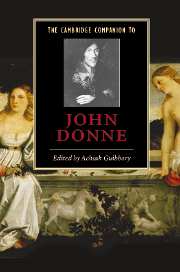Book contents
- Frontmatter
- 1 Donne’s life: a sketch
- 2 The text of Donne’s writings
- 3 The social context and nature of Donne’s writing: occasional verse and letters
- 4 Literary contexts: predecessors and contemporaries
- 5 Donne’s religious world
- 6 Donne’s political world
- 7 Reading and rereading Donne’s poetry
- 8 Satirical writing: Donne in shadows
- 9 Erotic poetry
- 10 Devotional writing
- 11 Donne as preacher
- 12 Donne’s language: the conditions of communication
- 13 Gender matters: the women in Donne’s poems
- 14 Facing death
- 15 Donne’s afterlife
- 16 Feeling thought: Donne and the embodied mind
- Select bibliography
- Index
- Series List
16 - Feeling thought: Donne and the embodied mind
Published online by Cambridge University Press: 28 November 2006
- Frontmatter
- 1 Donne’s life: a sketch
- 2 The text of Donne’s writings
- 3 The social context and nature of Donne’s writing: occasional verse and letters
- 4 Literary contexts: predecessors and contemporaries
- 5 Donne’s religious world
- 6 Donne’s political world
- 7 Reading and rereading Donne’s poetry
- 8 Satirical writing: Donne in shadows
- 9 Erotic poetry
- 10 Devotional writing
- 11 Donne as preacher
- 12 Donne’s language: the conditions of communication
- 13 Gender matters: the women in Donne’s poems
- 14 Facing death
- 15 Donne’s afterlife
- 16 Feeling thought: Donne and the embodied mind
- Select bibliography
- Index
- Series List
Summary
Ever since I discovered Donne, as a schoolgirl in the 1950s, I have been trying to puzzle out why he is so very exciting. The short-story writer, Frances Towers, remarked that women reading his love-poems feel seduced, which was true of the girl I was, though odd, since he wrote ''Hope not for minde in women'' and described them as, at their best ''Mummy, possest.'' He also speculated that women might not have souls, since there is no record of God having breathed one into Eve. Nevertheless, his great love-poems stir both body and mind in an electric way that resembles nothing else. As a student, I puzzled over T. S. Eliot's dictum about the dissociation of sensibility since the metaphysical poets. ''Tennyson and Browning are poets and they think; but they do not feel their thought as immediately as the odour of a rose.'' What precisely does it mean, to ''feel your thought''?
It seemed to me that Tennyson, who was despised when I was a student, felt his thoughts much more immediately than the Metaphysicals. Christopher Ricks indeed claimed that Tennyson thought precisely with sensuous images, fusing sensation and thought. The imagery of trees, for instance, in In Memoriam, contained in the musical chain of closed balladic verses, is a thought process made up of imagining the objects. Each tree changes all the other trees.
- Type
- Chapter
- Information
- The Cambridge Companion to John Donne , pp. 247 - 258Publisher: Cambridge University PressPrint publication year: 2006
- 5
- Cited by



